Financial Management Report: Financial Analysis of Tesco (HND)
VerifiedAdded on 2023/01/11
|22
|6081
|43
Report
AI Summary
This report analyzes the financial management practices of Tesco, a UK-based supermarket. It is divided into two scenarios, exploring various approaches, techniques, and factors contributing to effective decision-making within the organization. Scenario A evaluates stakeholder management, conflicting objectives, the value of management accounting in cost control and maximizing shareholder value, and techniques for fraud detection and ethical decision-making. Scenario B focuses on data informing operational and strategic decisions, investment appraisal techniques, the value of these techniques in decision-making, and the role of financial decision-making in supporting long-term sustainability, concluding with recommendations for management accounting support for financial sustainability. The report examines financial planning, cost accounting, fund flow analysis, and marginal costing techniques used by Tesco to inform decisions, increase efficiency, and ensure long-term growth. The analysis includes ratio calculations and financial statement analysis to effectively present the business operations.

Financial Management
Paraphrase This Document
Need a fresh take? Get an instant paraphrase of this document with our AI Paraphraser

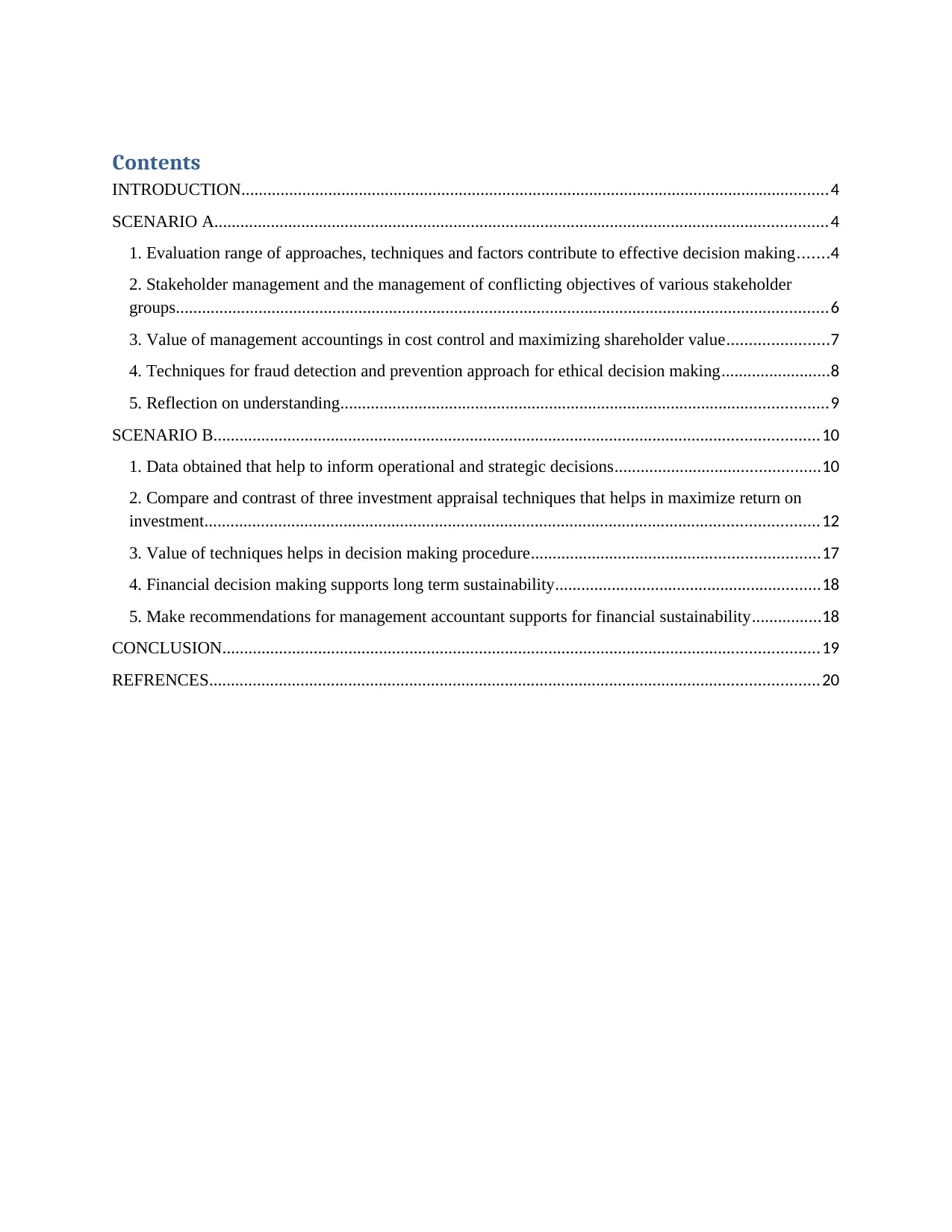
Contents
INTRODUCTION.......................................................................................................................................4
SCENARIO A.............................................................................................................................................4
1. Evaluation range of approaches, techniques and factors contribute to effective decision making.......4
2. Stakeholder management and the management of conflicting objectives of various stakeholder
groups......................................................................................................................................................6
3. Value of management accountings in cost control and maximizing shareholder value.......................7
4. Techniques for fraud detection and prevention approach for ethical decision making.........................8
5. Reflection on understanding................................................................................................................9
SCENARIO B...........................................................................................................................................10
1. Data obtained that help to inform operational and strategic decisions...............................................10
2. Compare and contrast of three investment appraisal techniques that helps in maximize return on
investment.............................................................................................................................................12
3. Value of techniques helps in decision making procedure..................................................................17
4. Financial decision making supports long term sustainability.............................................................18
5. Make recommendations for management accountant supports for financial sustainability................18
CONCLUSION.........................................................................................................................................19
REFRENCES............................................................................................................................................20
INTRODUCTION.......................................................................................................................................4
SCENARIO A.............................................................................................................................................4
1. Evaluation range of approaches, techniques and factors contribute to effective decision making.......4
2. Stakeholder management and the management of conflicting objectives of various stakeholder
groups......................................................................................................................................................6
3. Value of management accountings in cost control and maximizing shareholder value.......................7
4. Techniques for fraud detection and prevention approach for ethical decision making.........................8
5. Reflection on understanding................................................................................................................9
SCENARIO B...........................................................................................................................................10
1. Data obtained that help to inform operational and strategic decisions...............................................10
2. Compare and contrast of three investment appraisal techniques that helps in maximize return on
investment.............................................................................................................................................12
3. Value of techniques helps in decision making procedure..................................................................17
4. Financial decision making supports long term sustainability.............................................................18
5. Make recommendations for management accountant supports for financial sustainability................18
CONCLUSION.........................................................................................................................................19
REFRENCES............................................................................................................................................20
⊘ This is a preview!⊘
Do you want full access?
Subscribe today to unlock all pages.

Trusted by 1+ million students worldwide
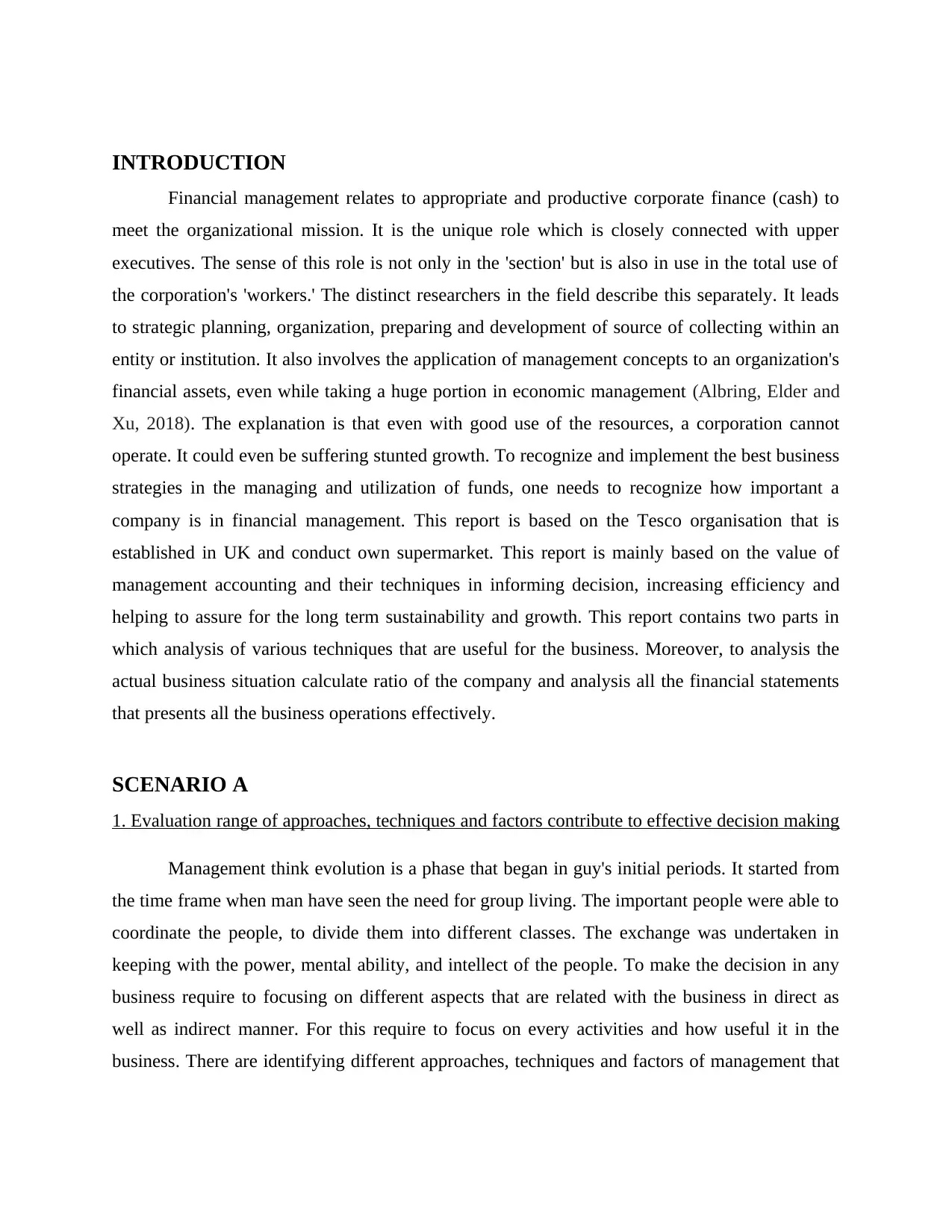
INTRODUCTION
Financial management relates to appropriate and productive corporate finance (cash) to
meet the organizational mission. It is the unique role which is closely connected with upper
executives. The sense of this role is not only in the 'section' but is also in use in the total use of
the corporation's 'workers.' The distinct researchers in the field describe this separately. It leads
to strategic planning, organization, preparing and development of source of collecting within an
entity or institution. It also involves the application of management concepts to an organization's
financial assets, even while taking a huge portion in economic management (Albring, Elder and
Xu, 2018). The explanation is that even with good use of the resources, a corporation cannot
operate. It could even be suffering stunted growth. To recognize and implement the best business
strategies in the managing and utilization of funds, one needs to recognize how important a
company is in financial management. This report is based on the Tesco organisation that is
established in UK and conduct own supermarket. This report is mainly based on the value of
management accounting and their techniques in informing decision, increasing efficiency and
helping to assure for the long term sustainability and growth. This report contains two parts in
which analysis of various techniques that are useful for the business. Moreover, to analysis the
actual business situation calculate ratio of the company and analysis all the financial statements
that presents all the business operations effectively.
SCENARIO A
1. Evaluation range of approaches, techniques and factors contribute to effective decision making
Management think evolution is a phase that began in guy's initial periods. It started from
the time frame when man have seen the need for group living. The important people were able to
coordinate the people, to divide them into different classes. The exchange was undertaken in
keeping with the power, mental ability, and intellect of the people. To make the decision in any
business require to focusing on different aspects that are related with the business in direct as
well as indirect manner. For this require to focus on every activities and how useful it in the
business. There are identifying different approaches, techniques and factors of management that
Financial management relates to appropriate and productive corporate finance (cash) to
meet the organizational mission. It is the unique role which is closely connected with upper
executives. The sense of this role is not only in the 'section' but is also in use in the total use of
the corporation's 'workers.' The distinct researchers in the field describe this separately. It leads
to strategic planning, organization, preparing and development of source of collecting within an
entity or institution. It also involves the application of management concepts to an organization's
financial assets, even while taking a huge portion in economic management (Albring, Elder and
Xu, 2018). The explanation is that even with good use of the resources, a corporation cannot
operate. It could even be suffering stunted growth. To recognize and implement the best business
strategies in the managing and utilization of funds, one needs to recognize how important a
company is in financial management. This report is based on the Tesco organisation that is
established in UK and conduct own supermarket. This report is mainly based on the value of
management accounting and their techniques in informing decision, increasing efficiency and
helping to assure for the long term sustainability and growth. This report contains two parts in
which analysis of various techniques that are useful for the business. Moreover, to analysis the
actual business situation calculate ratio of the company and analysis all the financial statements
that presents all the business operations effectively.
SCENARIO A
1. Evaluation range of approaches, techniques and factors contribute to effective decision making
Management think evolution is a phase that began in guy's initial periods. It started from
the time frame when man have seen the need for group living. The important people were able to
coordinate the people, to divide them into different classes. The exchange was undertaken in
keeping with the power, mental ability, and intellect of the people. To make the decision in any
business require to focusing on different aspects that are related with the business in direct as
well as indirect manner. For this require to focus on every activities and how useful it in the
business. There are identifying different approaches, techniques and factors of management that
Paraphrase This Document
Need a fresh take? Get an instant paraphrase of this document with our AI Paraphraser
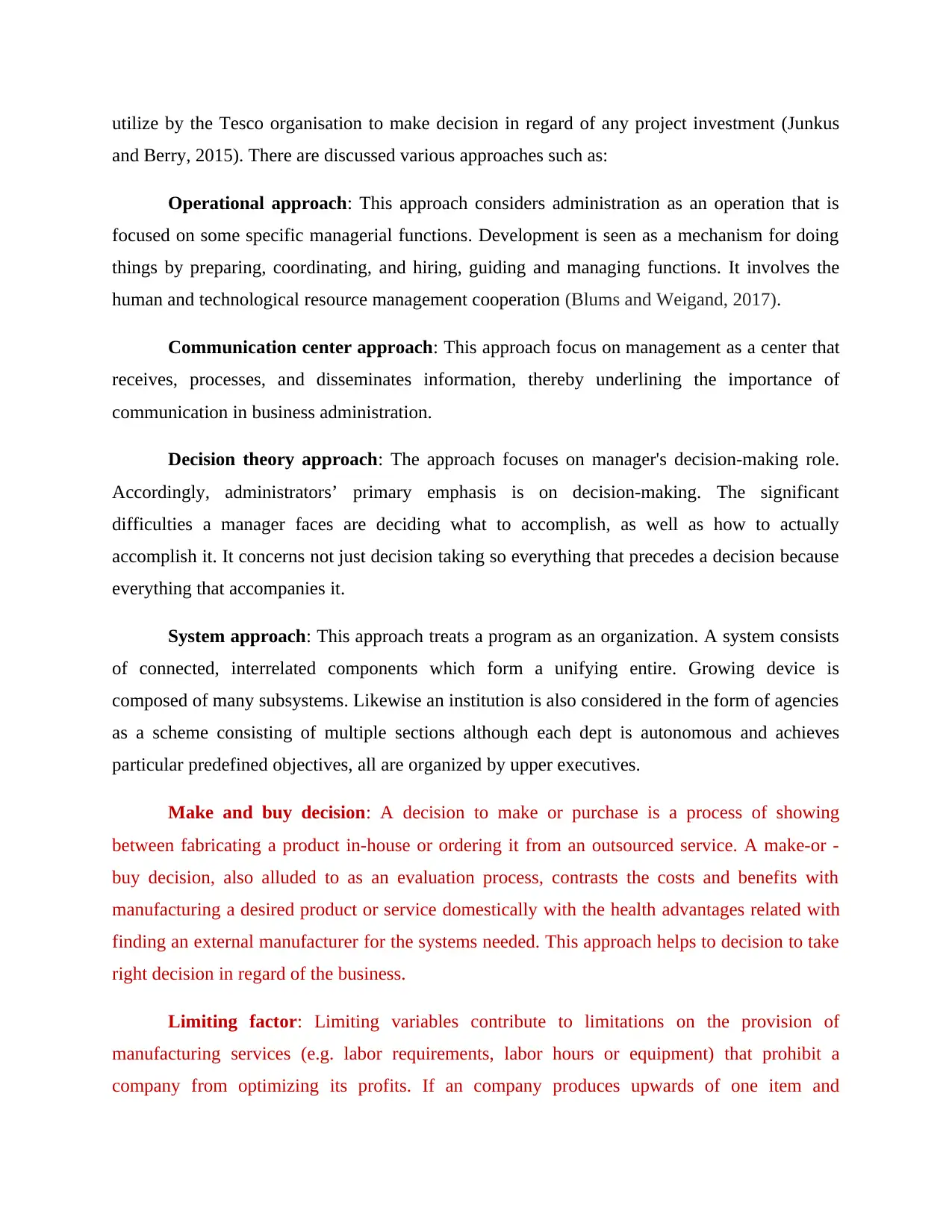
utilize by the Tesco organisation to make decision in regard of any project investment (Junkus
and Berry, 2015). There are discussed various approaches such as:
Operational approach: This approach considers administration as an operation that is
focused on some specific managerial functions. Development is seen as a mechanism for doing
things by preparing, coordinating, and hiring, guiding and managing functions. It involves the
human and technological resource management cooperation (Blums and Weigand, 2017).
Communication center approach: This approach focus on management as a center that
receives, processes, and disseminates information, thereby underlining the importance of
communication in business administration.
Decision theory approach: The approach focuses on manager's decision-making role.
Accordingly, administrators’ primary emphasis is on decision-making. The significant
difficulties a manager faces are deciding what to accomplish, as well as how to actually
accomplish it. It concerns not just decision taking so everything that precedes a decision because
everything that accompanies it.
System approach: This approach treats a program as an organization. A system consists
of connected, interrelated components which form a unifying entire. Growing device is
composed of many subsystems. Likewise an institution is also considered in the form of agencies
as a scheme consisting of multiple sections although each dept is autonomous and achieves
particular predefined objectives, all are organized by upper executives.
Make and buy decision: A decision to make or purchase is a process of showing
between fabricating a product in-house or ordering it from an outsourced service. A make-or -
buy decision, also alluded to as an evaluation process, contrasts the costs and benefits with
manufacturing a desired product or service domestically with the health advantages related with
finding an external manufacturer for the systems needed. This approach helps to decision to take
right decision in regard of the business.
Limiting factor: Limiting variables contribute to limitations on the provision of
manufacturing services (e.g. labor requirements, labor hours or equipment) that prohibit a
company from optimizing its profits. If an company produces upwards of one item and
and Berry, 2015). There are discussed various approaches such as:
Operational approach: This approach considers administration as an operation that is
focused on some specific managerial functions. Development is seen as a mechanism for doing
things by preparing, coordinating, and hiring, guiding and managing functions. It involves the
human and technological resource management cooperation (Blums and Weigand, 2017).
Communication center approach: This approach focus on management as a center that
receives, processes, and disseminates information, thereby underlining the importance of
communication in business administration.
Decision theory approach: The approach focuses on manager's decision-making role.
Accordingly, administrators’ primary emphasis is on decision-making. The significant
difficulties a manager faces are deciding what to accomplish, as well as how to actually
accomplish it. It concerns not just decision taking so everything that precedes a decision because
everything that accompanies it.
System approach: This approach treats a program as an organization. A system consists
of connected, interrelated components which form a unifying entire. Growing device is
composed of many subsystems. Likewise an institution is also considered in the form of agencies
as a scheme consisting of multiple sections although each dept is autonomous and achieves
particular predefined objectives, all are organized by upper executives.
Make and buy decision: A decision to make or purchase is a process of showing
between fabricating a product in-house or ordering it from an outsourced service. A make-or -
buy decision, also alluded to as an evaluation process, contrasts the costs and benefits with
manufacturing a desired product or service domestically with the health advantages related with
finding an external manufacturer for the systems needed. This approach helps to decision to take
right decision in regard of the business.
Limiting factor: Limiting variables contribute to limitations on the provision of
manufacturing services (e.g. labor requirements, labor hours or equipment) that prohibit a
company from optimizing its profits. If an company produces upwards of one item and
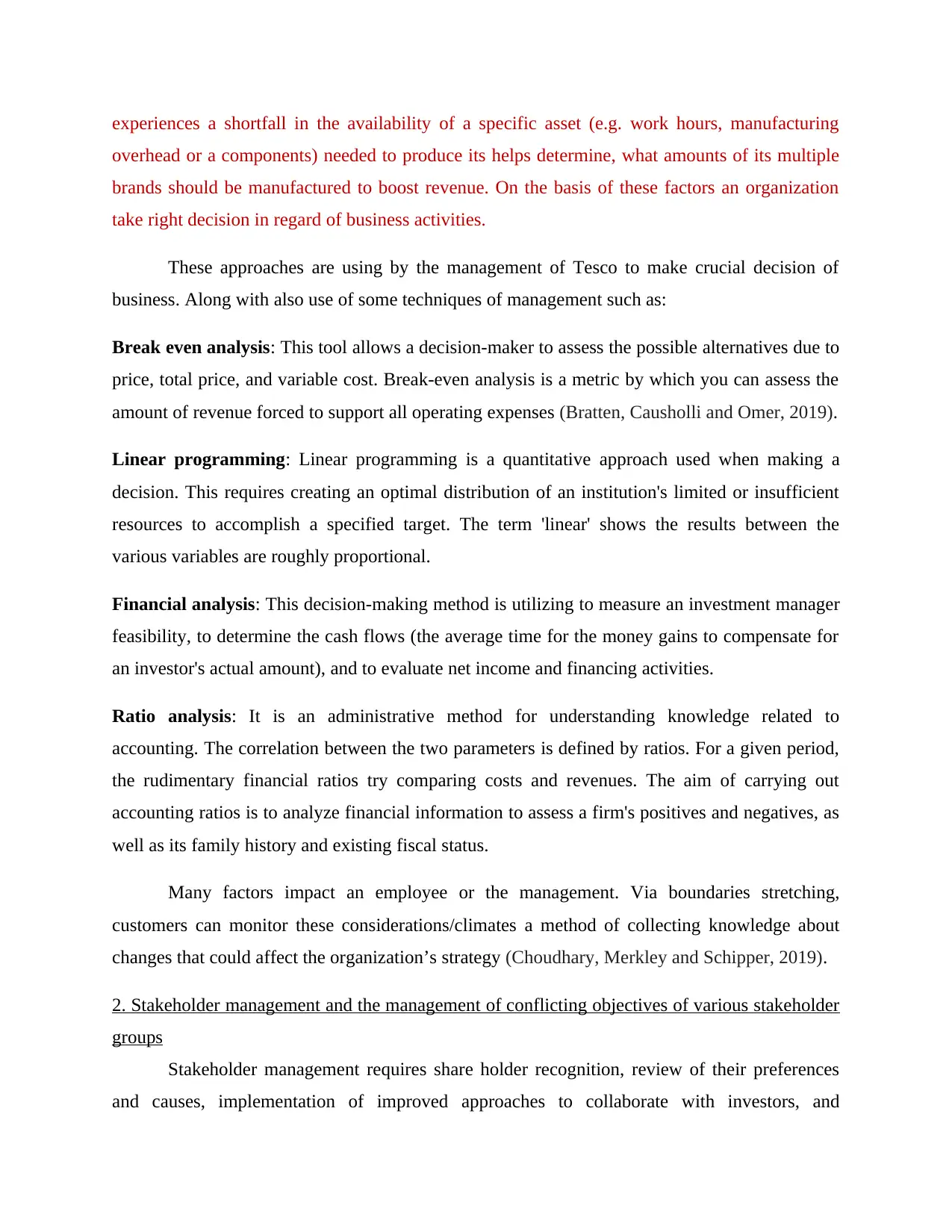
experiences a shortfall in the availability of a specific asset (e.g. work hours, manufacturing
overhead or a components) needed to produce its helps determine, what amounts of its multiple
brands should be manufactured to boost revenue. On the basis of these factors an organization
take right decision in regard of business activities.
These approaches are using by the management of Tesco to make crucial decision of
business. Along with also use of some techniques of management such as:
Break even analysis: This tool allows a decision-maker to assess the possible alternatives due to
price, total price, and variable cost. Break-even analysis is a metric by which you can assess the
amount of revenue forced to support all operating expenses (Bratten, Causholli and Omer, 2019).
Linear programming: Linear programming is a quantitative approach used when making a
decision. This requires creating an optimal distribution of an institution's limited or insufficient
resources to accomplish a specified target. The term 'linear' shows the results between the
various variables are roughly proportional.
Financial analysis: This decision-making method is utilizing to measure an investment manager
feasibility, to determine the cash flows (the average time for the money gains to compensate for
an investor's actual amount), and to evaluate net income and financing activities.
Ratio analysis: It is an administrative method for understanding knowledge related to
accounting. The correlation between the two parameters is defined by ratios. For a given period,
the rudimentary financial ratios try comparing costs and revenues. The aim of carrying out
accounting ratios is to analyze financial information to assess a firm's positives and negatives, as
well as its family history and existing fiscal status.
Many factors impact an employee or the management. Via boundaries stretching,
customers can monitor these considerations/climates a method of collecting knowledge about
changes that could affect the organization’s strategy (Choudhary, Merkley and Schipper, 2019).
2. Stakeholder management and the management of conflicting objectives of various stakeholder
groups
Stakeholder management requires share holder recognition, review of their preferences
and causes, implementation of improved approaches to collaborate with investors, and
overhead or a components) needed to produce its helps determine, what amounts of its multiple
brands should be manufactured to boost revenue. On the basis of these factors an organization
take right decision in regard of business activities.
These approaches are using by the management of Tesco to make crucial decision of
business. Along with also use of some techniques of management such as:
Break even analysis: This tool allows a decision-maker to assess the possible alternatives due to
price, total price, and variable cost. Break-even analysis is a metric by which you can assess the
amount of revenue forced to support all operating expenses (Bratten, Causholli and Omer, 2019).
Linear programming: Linear programming is a quantitative approach used when making a
decision. This requires creating an optimal distribution of an institution's limited or insufficient
resources to accomplish a specified target. The term 'linear' shows the results between the
various variables are roughly proportional.
Financial analysis: This decision-making method is utilizing to measure an investment manager
feasibility, to determine the cash flows (the average time for the money gains to compensate for
an investor's actual amount), and to evaluate net income and financing activities.
Ratio analysis: It is an administrative method for understanding knowledge related to
accounting. The correlation between the two parameters is defined by ratios. For a given period,
the rudimentary financial ratios try comparing costs and revenues. The aim of carrying out
accounting ratios is to analyze financial information to assess a firm's positives and negatives, as
well as its family history and existing fiscal status.
Many factors impact an employee or the management. Via boundaries stretching,
customers can monitor these considerations/climates a method of collecting knowledge about
changes that could affect the organization’s strategy (Choudhary, Merkley and Schipper, 2019).
2. Stakeholder management and the management of conflicting objectives of various stakeholder
groups
Stakeholder management requires share holder recognition, review of their preferences
and causes, implementation of improved approaches to collaborate with investors, and
⊘ This is a preview!⊘
Do you want full access?
Subscribe today to unlock all pages.

Trusted by 1+ million students worldwide
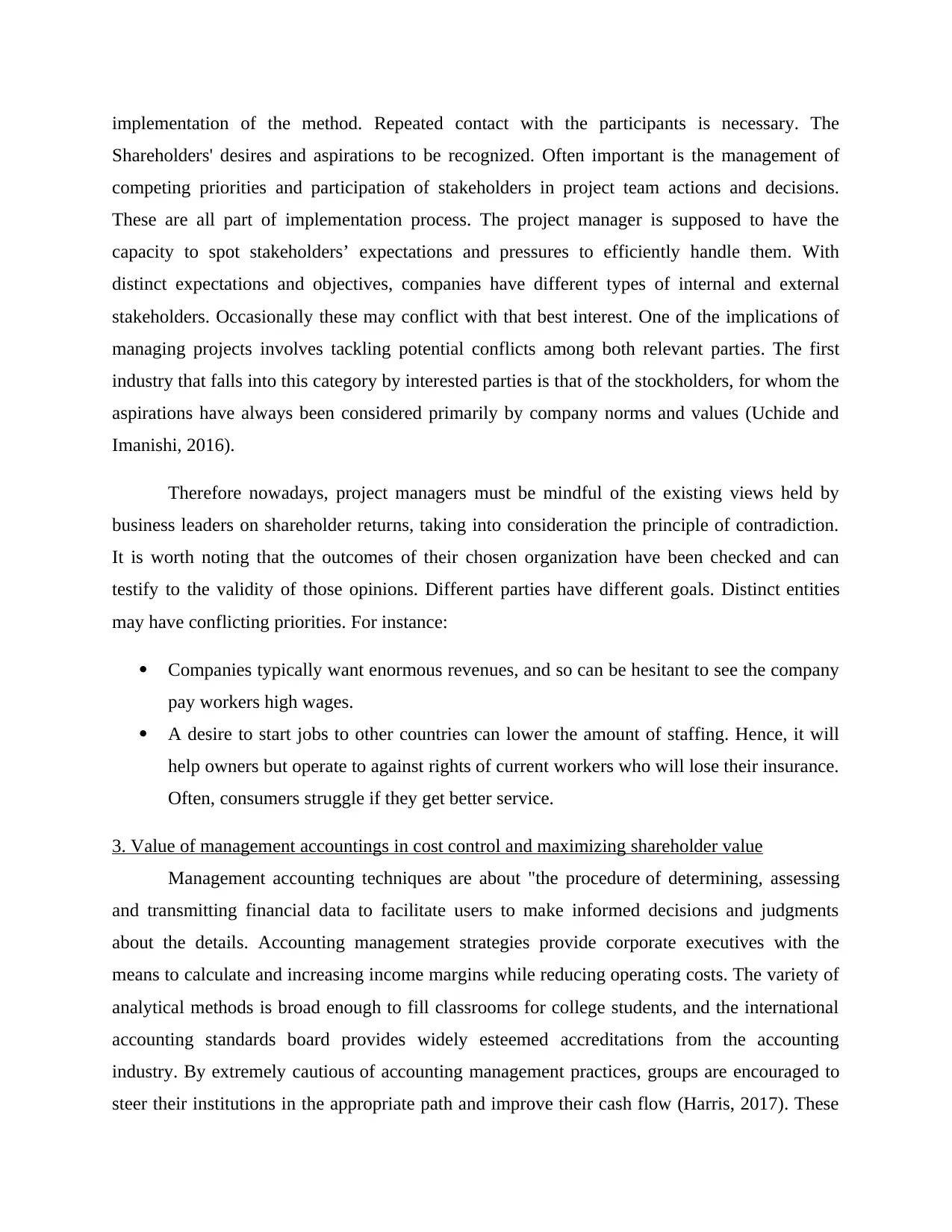
implementation of the method. Repeated contact with the participants is necessary. The
Shareholders' desires and aspirations to be recognized. Often important is the management of
competing priorities and participation of stakeholders in project team actions and decisions.
These are all part of implementation process. The project manager is supposed to have the
capacity to spot stakeholders’ expectations and pressures to efficiently handle them. With
distinct expectations and objectives, companies have different types of internal and external
stakeholders. Occasionally these may conflict with that best interest. One of the implications of
managing projects involves tackling potential conflicts among both relevant parties. The first
industry that falls into this category by interested parties is that of the stockholders, for whom the
aspirations have always been considered primarily by company norms and values (Uchide and
Imanishi, 2016).
Therefore nowadays, project managers must be mindful of the existing views held by
business leaders on shareholder returns, taking into consideration the principle of contradiction.
It is worth noting that the outcomes of their chosen organization have been checked and can
testify to the validity of those opinions. Different parties have different goals. Distinct entities
may have conflicting priorities. For instance:
Companies typically want enormous revenues, and so can be hesitant to see the company
pay workers high wages.
A desire to start jobs to other countries can lower the amount of staffing. Hence, it will
help owners but operate to against rights of current workers who will lose their insurance.
Often, consumers struggle if they get better service.
3. Value of management accountings in cost control and maximizing shareholder value
Management accounting techniques are about "the procedure of determining, assessing
and transmitting financial data to facilitate users to make informed decisions and judgments
about the details. Accounting management strategies provide corporate executives with the
means to calculate and increasing income margins while reducing operating costs. The variety of
analytical methods is broad enough to fill classrooms for college students, and the international
accounting standards board provides widely esteemed accreditations from the accounting
industry. By extremely cautious of accounting management practices, groups are encouraged to
steer their institutions in the appropriate path and improve their cash flow (Harris, 2017). These
Shareholders' desires and aspirations to be recognized. Often important is the management of
competing priorities and participation of stakeholders in project team actions and decisions.
These are all part of implementation process. The project manager is supposed to have the
capacity to spot stakeholders’ expectations and pressures to efficiently handle them. With
distinct expectations and objectives, companies have different types of internal and external
stakeholders. Occasionally these may conflict with that best interest. One of the implications of
managing projects involves tackling potential conflicts among both relevant parties. The first
industry that falls into this category by interested parties is that of the stockholders, for whom the
aspirations have always been considered primarily by company norms and values (Uchide and
Imanishi, 2016).
Therefore nowadays, project managers must be mindful of the existing views held by
business leaders on shareholder returns, taking into consideration the principle of contradiction.
It is worth noting that the outcomes of their chosen organization have been checked and can
testify to the validity of those opinions. Different parties have different goals. Distinct entities
may have conflicting priorities. For instance:
Companies typically want enormous revenues, and so can be hesitant to see the company
pay workers high wages.
A desire to start jobs to other countries can lower the amount of staffing. Hence, it will
help owners but operate to against rights of current workers who will lose their insurance.
Often, consumers struggle if they get better service.
3. Value of management accountings in cost control and maximizing shareholder value
Management accounting techniques are about "the procedure of determining, assessing
and transmitting financial data to facilitate users to make informed decisions and judgments
about the details. Accounting management strategies provide corporate executives with the
means to calculate and increasing income margins while reducing operating costs. The variety of
analytical methods is broad enough to fill classrooms for college students, and the international
accounting standards board provides widely esteemed accreditations from the accounting
industry. By extremely cautious of accounting management practices, groups are encouraged to
steer their institutions in the appropriate path and improve their cash flow (Harris, 2017). These
Paraphrase This Document
Need a fresh take? Get an instant paraphrase of this document with our AI Paraphraser
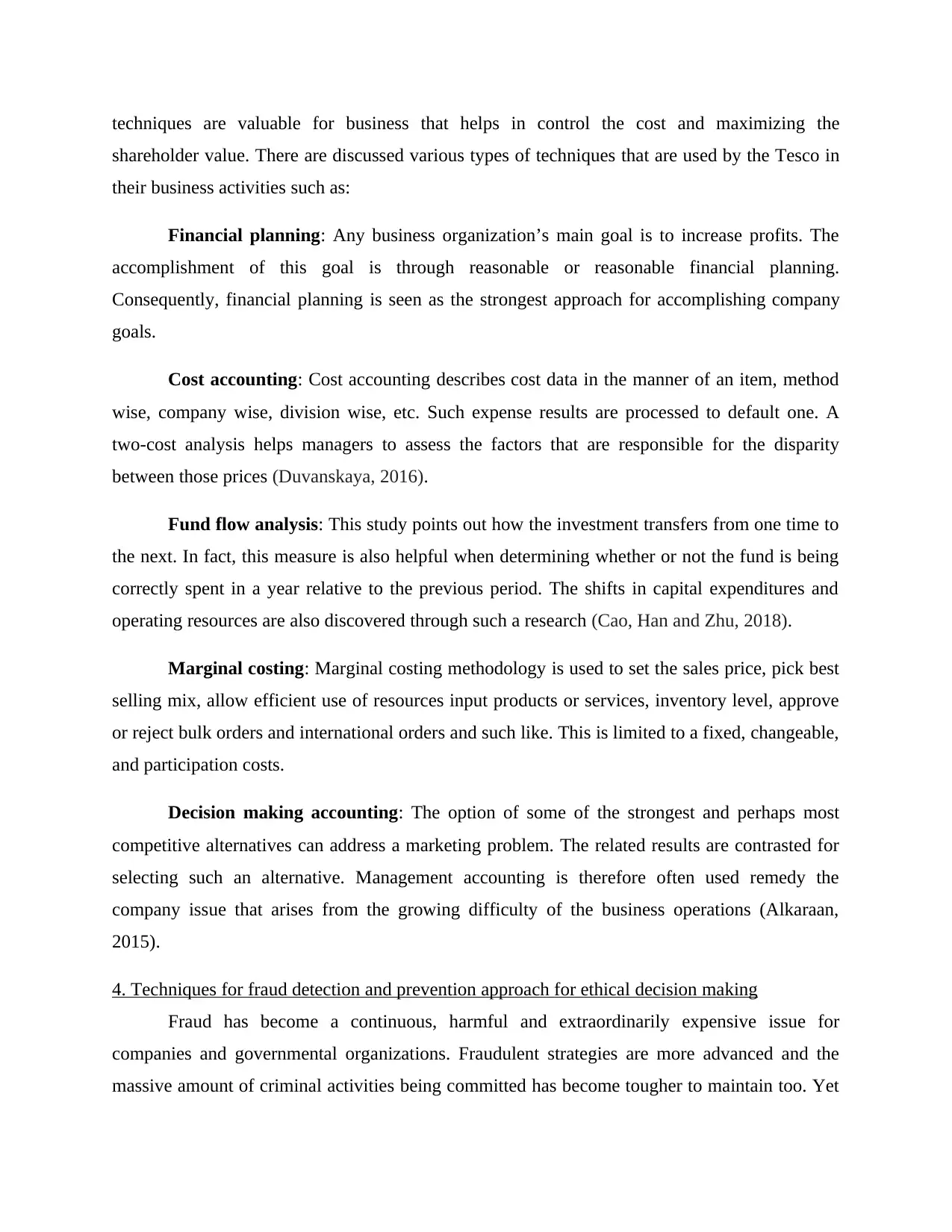
techniques are valuable for business that helps in control the cost and maximizing the
shareholder value. There are discussed various types of techniques that are used by the Tesco in
their business activities such as:
Financial planning: Any business organization’s main goal is to increase profits. The
accomplishment of this goal is through reasonable or reasonable financial planning.
Consequently, financial planning is seen as the strongest approach for accomplishing company
goals.
Cost accounting: Cost accounting describes cost data in the manner of an item, method
wise, company wise, division wise, etc. Such expense results are processed to default one. A
two-cost analysis helps managers to assess the factors that are responsible for the disparity
between those prices (Duvanskaya, 2016).
Fund flow analysis: This study points out how the investment transfers from one time to
the next. In fact, this measure is also helpful when determining whether or not the fund is being
correctly spent in a year relative to the previous period. The shifts in capital expenditures and
operating resources are also discovered through such a research (Cao, Han and Zhu, 2018).
Marginal costing: Marginal costing methodology is used to set the sales price, pick best
selling mix, allow efficient use of resources input products or services, inventory level, approve
or reject bulk orders and international orders and such like. This is limited to a fixed, changeable,
and participation costs.
Decision making accounting: The option of some of the strongest and perhaps most
competitive alternatives can address a marketing problem. The related results are contrasted for
selecting such an alternative. Management accounting is therefore often used remedy the
company issue that arises from the growing difficulty of the business operations (Alkaraan,
2015).
4. Techniques for fraud detection and prevention approach for ethical decision making
Fraud has become a continuous, harmful and extraordinarily expensive issue for
companies and governmental organizations. Fraudulent strategies are more advanced and the
massive amount of criminal activities being committed has become tougher to maintain too. Yet
shareholder value. There are discussed various types of techniques that are used by the Tesco in
their business activities such as:
Financial planning: Any business organization’s main goal is to increase profits. The
accomplishment of this goal is through reasonable or reasonable financial planning.
Consequently, financial planning is seen as the strongest approach for accomplishing company
goals.
Cost accounting: Cost accounting describes cost data in the manner of an item, method
wise, company wise, division wise, etc. Such expense results are processed to default one. A
two-cost analysis helps managers to assess the factors that are responsible for the disparity
between those prices (Duvanskaya, 2016).
Fund flow analysis: This study points out how the investment transfers from one time to
the next. In fact, this measure is also helpful when determining whether or not the fund is being
correctly spent in a year relative to the previous period. The shifts in capital expenditures and
operating resources are also discovered through such a research (Cao, Han and Zhu, 2018).
Marginal costing: Marginal costing methodology is used to set the sales price, pick best
selling mix, allow efficient use of resources input products or services, inventory level, approve
or reject bulk orders and international orders and such like. This is limited to a fixed, changeable,
and participation costs.
Decision making accounting: The option of some of the strongest and perhaps most
competitive alternatives can address a marketing problem. The related results are contrasted for
selecting such an alternative. Management accounting is therefore often used remedy the
company issue that arises from the growing difficulty of the business operations (Alkaraan,
2015).
4. Techniques for fraud detection and prevention approach for ethical decision making
Fraud has become a continuous, harmful and extraordinarily expensive issue for
companies and governmental organizations. Fraudulent strategies are more advanced and the
massive amount of criminal activities being committed has become tougher to maintain too. Yet
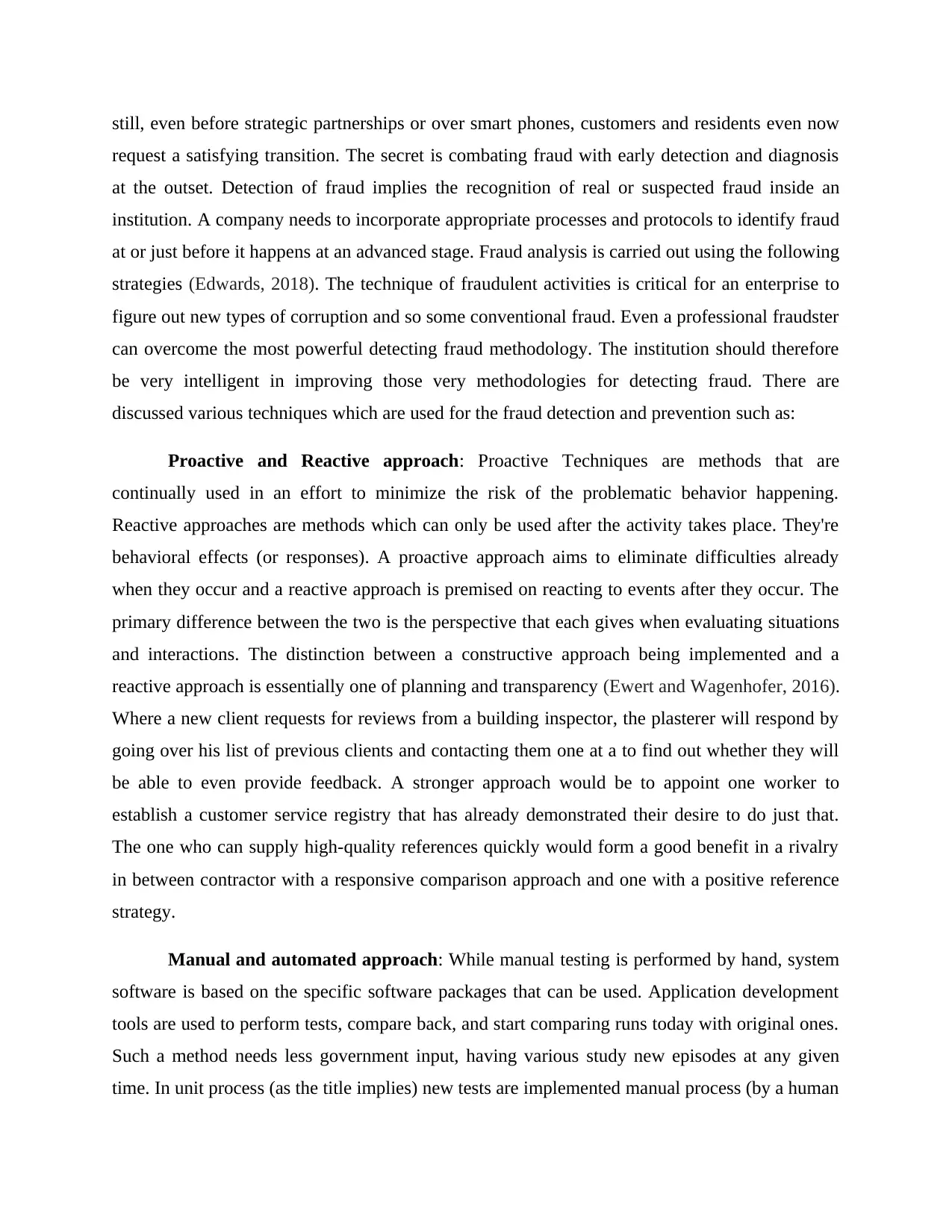
still, even before strategic partnerships or over smart phones, customers and residents even now
request a satisfying transition. The secret is combating fraud with early detection and diagnosis
at the outset. Detection of fraud implies the recognition of real or suspected fraud inside an
institution. A company needs to incorporate appropriate processes and protocols to identify fraud
at or just before it happens at an advanced stage. Fraud analysis is carried out using the following
strategies (Edwards, 2018). The technique of fraudulent activities is critical for an enterprise to
figure out new types of corruption and so some conventional fraud. Even a professional fraudster
can overcome the most powerful detecting fraud methodology. The institution should therefore
be very intelligent in improving those very methodologies for detecting fraud. There are
discussed various techniques which are used for the fraud detection and prevention such as:
Proactive and Reactive approach: Proactive Techniques are methods that are
continually used in an effort to minimize the risk of the problematic behavior happening.
Reactive approaches are methods which can only be used after the activity takes place. They're
behavioral effects (or responses). A proactive approach aims to eliminate difficulties already
when they occur and a reactive approach is premised on reacting to events after they occur. The
primary difference between the two is the perspective that each gives when evaluating situations
and interactions. The distinction between a constructive approach being implemented and a
reactive approach is essentially one of planning and transparency (Ewert and Wagenhofer, 2016).
Where a new client requests for reviews from a building inspector, the plasterer will respond by
going over his list of previous clients and contacting them one at a to find out whether they will
be able to even provide feedback. A stronger approach would be to appoint one worker to
establish a customer service registry that has already demonstrated their desire to do just that.
The one who can supply high-quality references quickly would form a good benefit in a rivalry
in between contractor with a responsive comparison approach and one with a positive reference
strategy.
Manual and automated approach: While manual testing is performed by hand, system
software is based on the specific software packages that can be used. Application development
tools are used to perform tests, compare back, and start comparing runs today with original ones.
Such a method needs less government input, having various study new episodes at any given
time. In unit process (as the title implies) new tests are implemented manual process (by a human
request a satisfying transition. The secret is combating fraud with early detection and diagnosis
at the outset. Detection of fraud implies the recognition of real or suspected fraud inside an
institution. A company needs to incorporate appropriate processes and protocols to identify fraud
at or just before it happens at an advanced stage. Fraud analysis is carried out using the following
strategies (Edwards, 2018). The technique of fraudulent activities is critical for an enterprise to
figure out new types of corruption and so some conventional fraud. Even a professional fraudster
can overcome the most powerful detecting fraud methodology. The institution should therefore
be very intelligent in improving those very methodologies for detecting fraud. There are
discussed various techniques which are used for the fraud detection and prevention such as:
Proactive and Reactive approach: Proactive Techniques are methods that are
continually used in an effort to minimize the risk of the problematic behavior happening.
Reactive approaches are methods which can only be used after the activity takes place. They're
behavioral effects (or responses). A proactive approach aims to eliminate difficulties already
when they occur and a reactive approach is premised on reacting to events after they occur. The
primary difference between the two is the perspective that each gives when evaluating situations
and interactions. The distinction between a constructive approach being implemented and a
reactive approach is essentially one of planning and transparency (Ewert and Wagenhofer, 2016).
Where a new client requests for reviews from a building inspector, the plasterer will respond by
going over his list of previous clients and contacting them one at a to find out whether they will
be able to even provide feedback. A stronger approach would be to appoint one worker to
establish a customer service registry that has already demonstrated their desire to do just that.
The one who can supply high-quality references quickly would form a good benefit in a rivalry
in between contractor with a responsive comparison approach and one with a positive reference
strategy.
Manual and automated approach: While manual testing is performed by hand, system
software is based on the specific software packages that can be used. Application development
tools are used to perform tests, compare back, and start comparing runs today with original ones.
Such a method needs less government input, having various study new episodes at any given
time. In unit process (as the title implies) new tests are implemented manual process (by a human
⊘ This is a preview!⊘
Do you want full access?
Subscribe today to unlock all pages.

Trusted by 1+ million students worldwide
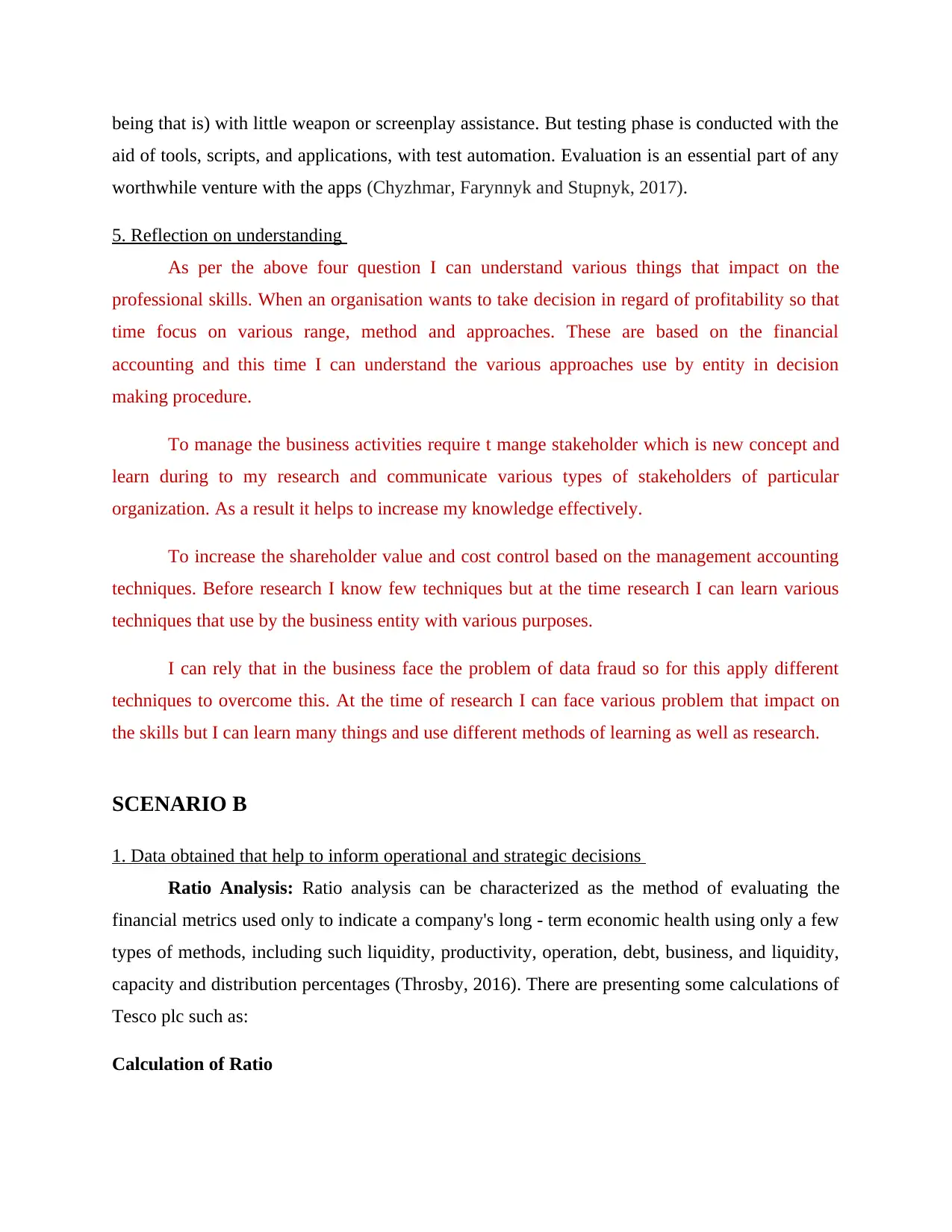
being that is) with little weapon or screenplay assistance. But testing phase is conducted with the
aid of tools, scripts, and applications, with test automation. Evaluation is an essential part of any
worthwhile venture with the apps (Chyzhmar, Farynnyk and Stupnyk, 2017).
5. Reflection on understanding
As per the above four question I can understand various things that impact on the
professional skills. When an organisation wants to take decision in regard of profitability so that
time focus on various range, method and approaches. These are based on the financial
accounting and this time I can understand the various approaches use by entity in decision
making procedure.
To manage the business activities require t mange stakeholder which is new concept and
learn during to my research and communicate various types of stakeholders of particular
organization. As a result it helps to increase my knowledge effectively.
To increase the shareholder value and cost control based on the management accounting
techniques. Before research I know few techniques but at the time research I can learn various
techniques that use by the business entity with various purposes.
I can rely that in the business face the problem of data fraud so for this apply different
techniques to overcome this. At the time of research I can face various problem that impact on
the skills but I can learn many things and use different methods of learning as well as research.
SCENARIO B
1. Data obtained that help to inform operational and strategic decisions
Ratio Analysis: Ratio analysis can be characterized as the method of evaluating the
financial metrics used only to indicate a company's long - term economic health using only a few
types of methods, including such liquidity, productivity, operation, debt, business, and liquidity,
capacity and distribution percentages (Throsby, 2016). There are presenting some calculations of
Tesco plc such as:
Calculation of Ratio
aid of tools, scripts, and applications, with test automation. Evaluation is an essential part of any
worthwhile venture with the apps (Chyzhmar, Farynnyk and Stupnyk, 2017).
5. Reflection on understanding
As per the above four question I can understand various things that impact on the
professional skills. When an organisation wants to take decision in regard of profitability so that
time focus on various range, method and approaches. These are based on the financial
accounting and this time I can understand the various approaches use by entity in decision
making procedure.
To manage the business activities require t mange stakeholder which is new concept and
learn during to my research and communicate various types of stakeholders of particular
organization. As a result it helps to increase my knowledge effectively.
To increase the shareholder value and cost control based on the management accounting
techniques. Before research I know few techniques but at the time research I can learn various
techniques that use by the business entity with various purposes.
I can rely that in the business face the problem of data fraud so for this apply different
techniques to overcome this. At the time of research I can face various problem that impact on
the skills but I can learn many things and use different methods of learning as well as research.
SCENARIO B
1. Data obtained that help to inform operational and strategic decisions
Ratio Analysis: Ratio analysis can be characterized as the method of evaluating the
financial metrics used only to indicate a company's long - term economic health using only a few
types of methods, including such liquidity, productivity, operation, debt, business, and liquidity,
capacity and distribution percentages (Throsby, 2016). There are presenting some calculations of
Tesco plc such as:
Calculation of Ratio
Paraphrase This Document
Need a fresh take? Get an instant paraphrase of this document with our AI Paraphraser
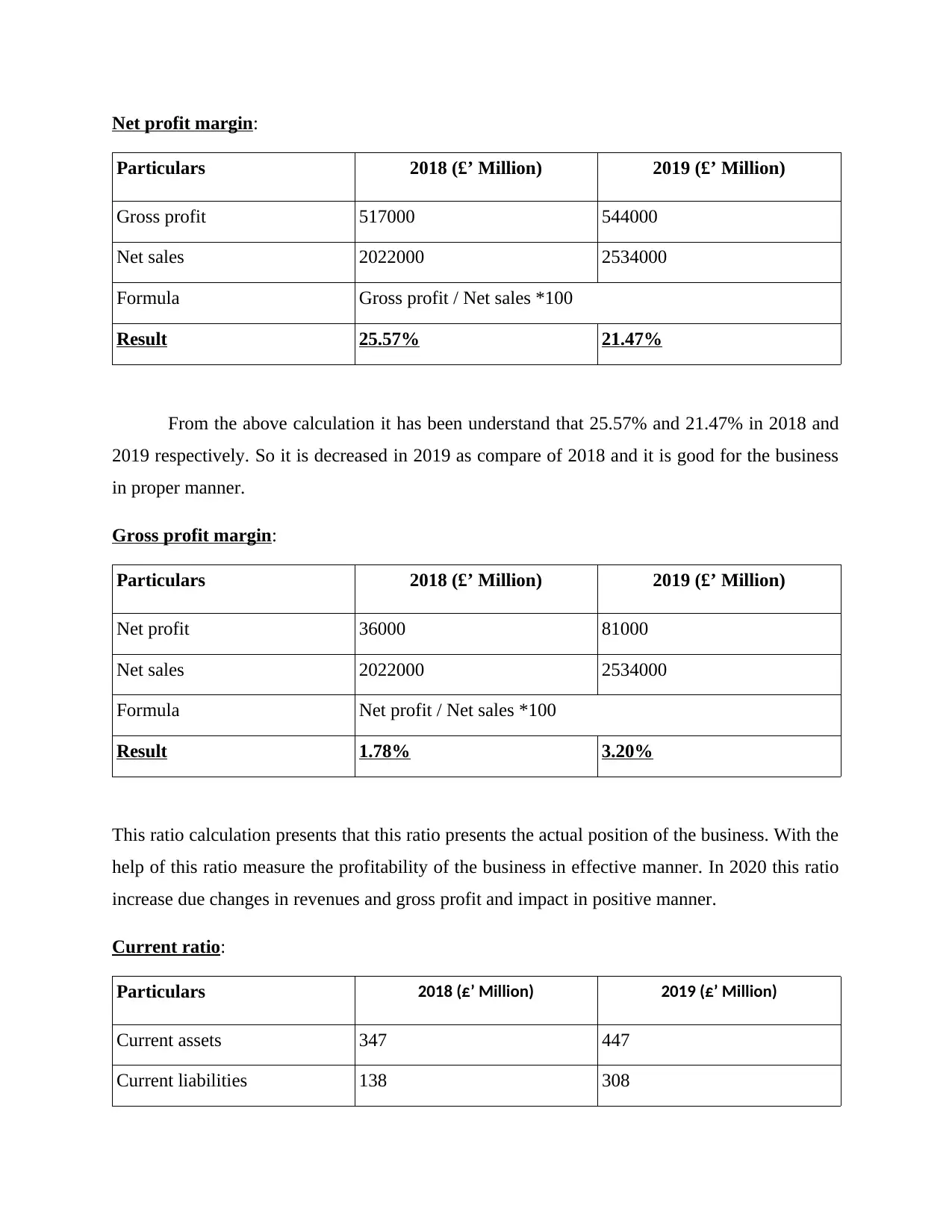
Net profit margin:
Particulars 2018 (£’ Million) 2019 (£’ Million)
Gross profit 517000 544000
Net sales 2022000 2534000
Formula Gross profit / Net sales *100
Result 25.57% 21.47%
From the above calculation it has been understand that 25.57% and 21.47% in 2018 and
2019 respectively. So it is decreased in 2019 as compare of 2018 and it is good for the business
in proper manner.
Gross profit margin:
Particulars 2018 (£’ Million) 2019 (£’ Million)
Net profit 36000 81000
Net sales 2022000 2534000
Formula Net profit / Net sales *100
Result 1.78% 3.20%
This ratio calculation presents that this ratio presents the actual position of the business. With the
help of this ratio measure the profitability of the business in effective manner. In 2020 this ratio
increase due changes in revenues and gross profit and impact in positive manner.
Current ratio:
Particulars 2018 (£’ Million) 2019 (£’ Million)
Current assets 347 447
Current liabilities 138 308
Particulars 2018 (£’ Million) 2019 (£’ Million)
Gross profit 517000 544000
Net sales 2022000 2534000
Formula Gross profit / Net sales *100
Result 25.57% 21.47%
From the above calculation it has been understand that 25.57% and 21.47% in 2018 and
2019 respectively. So it is decreased in 2019 as compare of 2018 and it is good for the business
in proper manner.
Gross profit margin:
Particulars 2018 (£’ Million) 2019 (£’ Million)
Net profit 36000 81000
Net sales 2022000 2534000
Formula Net profit / Net sales *100
Result 1.78% 3.20%
This ratio calculation presents that this ratio presents the actual position of the business. With the
help of this ratio measure the profitability of the business in effective manner. In 2020 this ratio
increase due changes in revenues and gross profit and impact in positive manner.
Current ratio:
Particulars 2018 (£’ Million) 2019 (£’ Million)
Current assets 347 447
Current liabilities 138 308
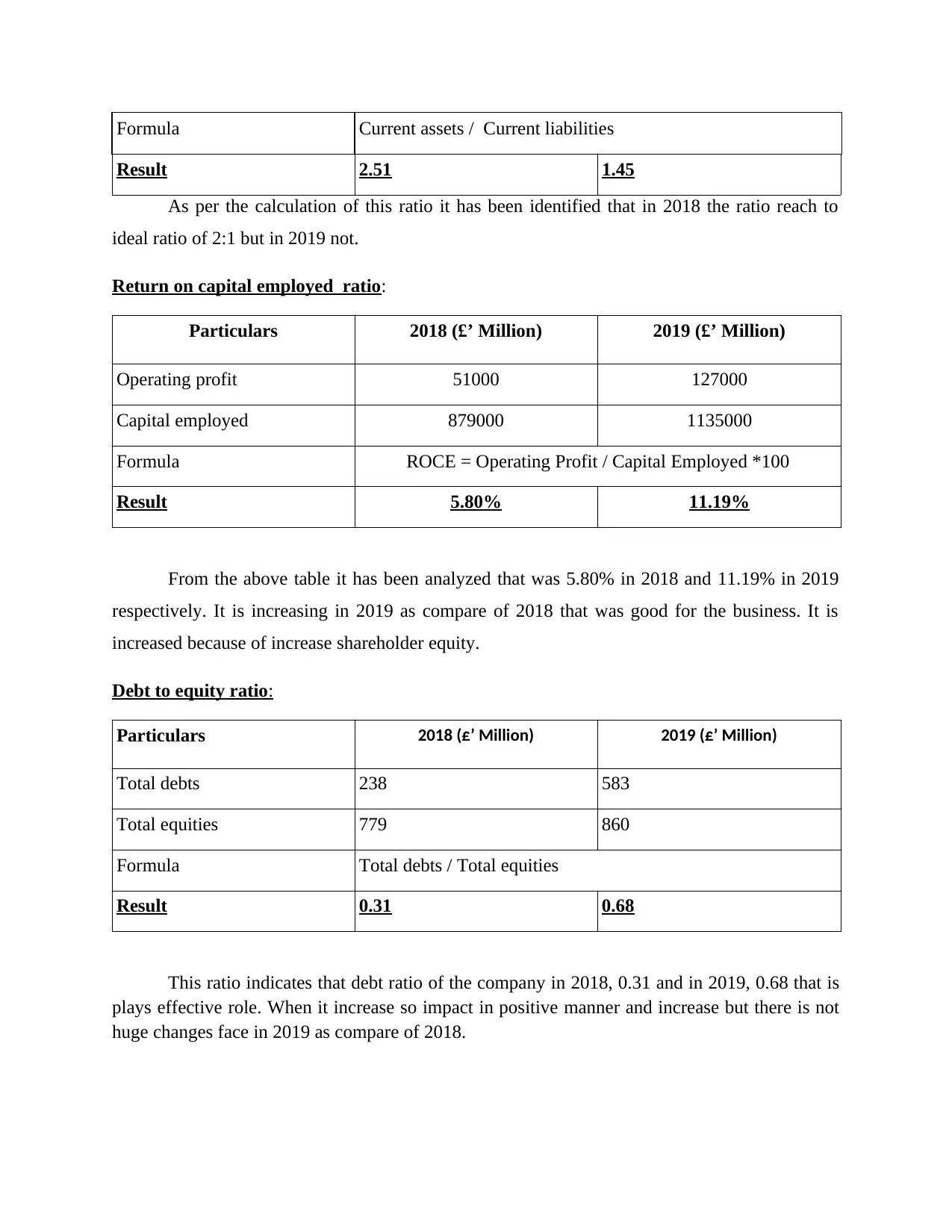
Formula Current assets / Current liabilities
Result 2.51 1.45
As per the calculation of this ratio it has been identified that in 2018 the ratio reach to
ideal ratio of 2:1 but in 2019 not.
Return on capital employed ratio:
Particulars 2018 (£’ Million) 2019 (£’ Million)
Operating profit 51000 127000
Capital employed 879000 1135000
Formula ROCE = Operating Profit / Capital Employed *100
Result 5.80% 11.19%
From the above table it has been analyzed that was 5.80% in 2018 and 11.19% in 2019
respectively. It is increasing in 2019 as compare of 2018 that was good for the business. It is
increased because of increase shareholder equity.
Debt to equity ratio:
Particulars 2018 (£’ Million) 2019 (£’ Million)
Total debts 238 583
Total equities 779 860
Formula Total debts / Total equities
Result 0.31 0.68
This ratio indicates that debt ratio of the company in 2018, 0.31 and in 2019, 0.68 that is
plays effective role. When it increase so impact in positive manner and increase but there is not
huge changes face in 2019 as compare of 2018.
Result 2.51 1.45
As per the calculation of this ratio it has been identified that in 2018 the ratio reach to
ideal ratio of 2:1 but in 2019 not.
Return on capital employed ratio:
Particulars 2018 (£’ Million) 2019 (£’ Million)
Operating profit 51000 127000
Capital employed 879000 1135000
Formula ROCE = Operating Profit / Capital Employed *100
Result 5.80% 11.19%
From the above table it has been analyzed that was 5.80% in 2018 and 11.19% in 2019
respectively. It is increasing in 2019 as compare of 2018 that was good for the business. It is
increased because of increase shareholder equity.
Debt to equity ratio:
Particulars 2018 (£’ Million) 2019 (£’ Million)
Total debts 238 583
Total equities 779 860
Formula Total debts / Total equities
Result 0.31 0.68
This ratio indicates that debt ratio of the company in 2018, 0.31 and in 2019, 0.68 that is
plays effective role. When it increase so impact in positive manner and increase but there is not
huge changes face in 2019 as compare of 2018.
⊘ This is a preview!⊘
Do you want full access?
Subscribe today to unlock all pages.

Trusted by 1+ million students worldwide
1 out of 22
Related Documents
Your All-in-One AI-Powered Toolkit for Academic Success.
+13062052269
info@desklib.com
Available 24*7 on WhatsApp / Email
![[object Object]](/_next/static/media/star-bottom.7253800d.svg)
Unlock your academic potential
Copyright © 2020–2025 A2Z Services. All Rights Reserved. Developed and managed by ZUCOL.





